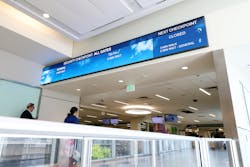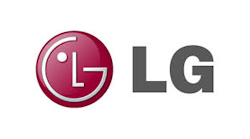Dallas Fort Worth International Airport (DFW) recently upgraded its signage at TSA security checkpoints from static to digital signage. The airport wanted to be proactive addressing information to travelers at the checkpoints to help them understand wait times.
Julio Badin, senior vice president of customer experience for DFW, said security queues are a stressful experience of the traveler’s journey, so the airport wanted take steps to reduce concerns.
“We saw an opportunity to be able to provide our customers additional information to make decisions to improve that experience,” he said. “Four out of our five terminals have three checkpoints and they’re within walking distance of each other.”
Daniel Wheeler, senior account manager for DVLED at LG, said, the information allows the airport to direct travelers away from one security checkpoint gate to a less busy one to address wait times.
DFW considered LCD and LED signage for the area. LED has a lack of seams and doesn’t have glare from a glass panel.
“The main content in that area is mainly text-based so LED was a great solution,” Wheeler said. “Although LED is great at video, it has real clear, crisp text and it offers additional brightness where LCD the glare will sometimes remove that brightness.”
Badin said the DVLED videoboards have brightness and ability to display across a landscape to avoid the issues of displaying across multiple monitors. They opted for the 1.89 pixel pitch in the monitors, because DFW preferred the aesthetic look.
“If there is an issue with a couple of LEDs going out, you just replace one thing pretty quickly,” Badin said.
LED has a 100,000 hour lifespan to half brightness, which is about double that of a standard LCD panel, Wheeler said.
“It should last twice as long as than LCD and it’s also a brighter solution,” he said.
The signs DFW used are direct view LED, with the exception of Terminal C where Badin said they opted for LCD while the airport determines the future renovations to the facility.
The LED signs directly replaced all the static signage. Some were mounted to the walls, others hung from the ceiling and others were double sided blade signs, which hang from a cantilever from a pole.
“You can maintain the same visual and the same pixel pitch, but configure the cabinets in different ways,” Wheeler said. “That also gives you a uniform look for all your signage throughout the entire airport.”
The biggest challenge was installing the signs after hours during low traffic flows. Mount providers had to work around other installed items like fire sprinklers and do load calculations. Each installation was done in three phases, which lasted about a week each.
All of the installations finished on time despite an expedited timeline.
“In one of the phases there were so many signs to install that we ran two separate crews because it was two separate terminals being installed at the same time,” Wheeler said. “But by the end of it, we were recreating the same thing we had done before.”
The final installation was completed in July.
Daniel Verbsky, senior account manager, vertical sales for transportation, said the customer experience has been smooth for DFW. People know how long the line will take and the accuracy has been good. The system uses sensors from Xovis to monitor movement though the line.
Badin said privacy is important to the airport, so they opted for the solution because there’s no visual feed of the customers, just dots representing them.
“We wanted to ensure the technology we were putting in was accurate and able to provide information the customers can rely on,” he said. “If it’s not accurate, then you lose trust of the customer.”
DFW expects to see improved customer satisfaction metrics and help TSA staff by providing good information.
“The TSA has really found the system a benefit because the information we’re getting helps them put their officers in the right place at the right time,” Badin said. “We have seen a reduction on overall wait times based on that and other factors.”
Starting from scratch at XWA
Celso Rodriguez, director of business development, digital signage at Infax Inc. said the company was tasked with providing the new Williston Basin International Airport (XWA) with a robust flight information display system and digital signage system. It needed to communicate flight information data and allow for in-house marketing and advertising.
“They really wanted something that was almost like a Swiss Army knife of systems where they can do multiple things,” he said. “Being able to direct the correct and timely information to their passengers was of the upmost importance, but on the same breath they wanted the capabilities to display really customized content so they can relay information to guests as much as they see fit.”
A total of 39 displays were put into XWA. Installation locations of each of the signs were picked by the designers.
Rodriguez said Infax had a team onsite to train airport staff on how to use the system.
Utilizing a multisystem approach to a digital signage software allows airports to manage its messaging and information from central system. Rodriguez said it allows airports to transition and push information out to passengers while obtaining feedback on messaging presentation.
“It’s really getting down to the data behind the actual digital signage,” he said. “Can we harness that information to really improve the passenger experience and are there any areas that need improvement as far as relaying information to passengers.
Bring the best to your airport
Badin said airports looking at a similar install as DFW should consider flow of customers to know where they need to install monitors. They also need a well-designed implementation plan and plan time to allow the technology to learn to provide accurate information.
He said airports also need to ensure their content management system can integrate with the technology.
“We were a bit surprised on how complicated getting that information to actually show up on the monitors is if you that content management solution isn’t robust enough to handle this new technology,” he said.
Rodriguez said an all-in-one system provides a scalable solution for smaller airports to enhance operations. As the airport expands, the system can as well.
“You’re getting the exact same treatment and the exact same system that a Hartsfield-Jackson Atlanta International Airport would be utilizing,” he said. “You’re having the full capabilities of a large hub airport to do similar activities on a smaller scale.
Rodriguez said smaller airports should know the functionality they’re looking for in a content management system. Some providers give a baseline system while others can be customized.
“How much are they going to be using the system and do they have the staff on site to utilize the system at its fullest,” he said.
The price point of LED has come down to make it affordable for smaller airports as well. Wheeler said. Airports had been generally using it for artistic displays, but now it has more potential.
“The trend for direct view LED keeps growing for the airports of all sizes,” Verbsky said. “It has hit the price point where it’s attractive as well as the maintenance cost.”
Providing dynamic information to travelers is beneficial to airports of all sizes. Wheeler said the majority of travelers are infrequent, so presenting them information like this is going to be beneficial.
“We’ve all been to the airport and seen that long line and think it’s going to take 45 minutes, but in the end the security really goes fairly quickly,” Wheeler said. “There’s a lot of people who don’t travel on a regular basis, they see those lines and they freak out. But this gives them that piece of mind.”
Airports looking at LED or other digital signage need to consider the business case. Then consider the content on display, text size, video, advertising and who will be the target viewing audience, Wheeler said.
“With the security gates, we went with 1.8 millimeter pixel pitch,” he said. “We considered a tighter pixel pitch and one a little further apart, but after DFW reviewed pixel pitches based on the distance from the average person’s eyes to the display, we took that into account to find a pixel pitch that fit so the displays look really good from where the person is viewing from.”









